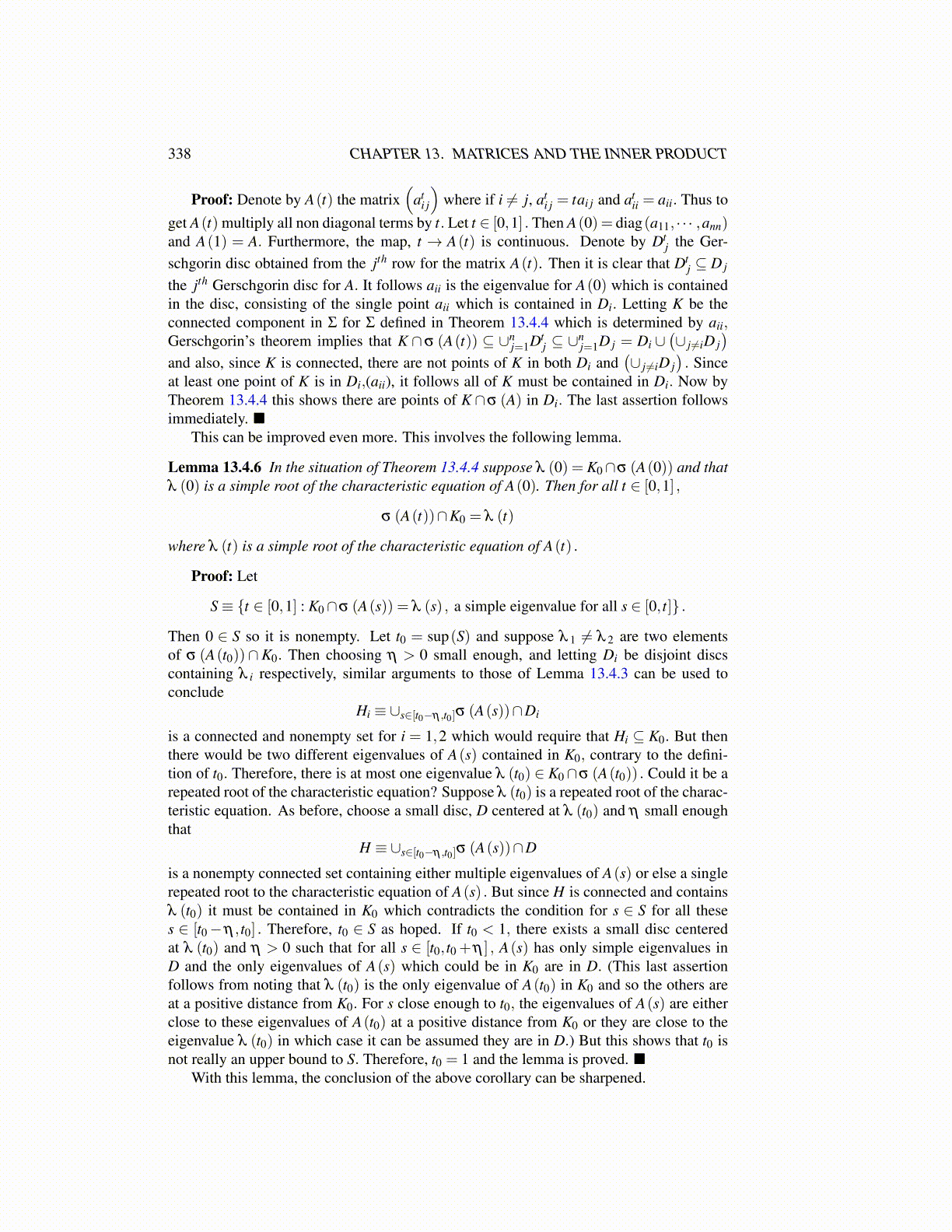
338 CHAPTER 13. MATRICES AND THE INNER PRODUCT
Proof: Denote by A(t) the matrix(
ati j
)where if i ̸= j, at
i j = tai j and atii = aii. Thus to
get A(t) multiply all non diagonal terms by t. Let t ∈ [0,1] . Then A(0) = diag(a11, · · · ,ann)and A(1) = A. Furthermore, the map, t → A(t) is continuous. Denote by Dt
j the Ger-schgorin disc obtained from the jth row for the matrix A(t). Then it is clear that Dt
j ⊆ D j
the jth Gerschgorin disc for A. It follows aii is the eigenvalue for A(0) which is containedin the disc, consisting of the single point aii which is contained in Di. Letting K be theconnected component in Σ for Σ defined in Theorem 13.4.4 which is determined by aii,Gerschgorin’s theorem implies that K ∩ σ (A(t)) ⊆ ∪n
j=1Dtj ⊆ ∪n
j=1D j = Di ∪(∪ j ̸=iD j
)and also, since K is connected, there are not points of K in both Di and
(∪ j ̸=iD j
). Since
at least one point of K is in Di,(aii), it follows all of K must be contained in Di. Now byTheorem 13.4.4 this shows there are points of K ∩σ (A) in Di. The last assertion followsimmediately. ■
This can be improved even more. This involves the following lemma.
Lemma 13.4.6 In the situation of Theorem 13.4.4 suppose λ (0) = K0∩σ (A(0)) and thatλ (0) is a simple root of the characteristic equation of A(0). Then for all t ∈ [0,1] ,
σ (A(t))∩K0 = λ (t)
where λ (t) is a simple root of the characteristic equation of A(t) .
Proof: Let
S≡ {t ∈ [0,1] : K0∩σ (A(s)) = λ (s) , a simple eigenvalue for all s ∈ [0, t]} .
Then 0 ∈ S so it is nonempty. Let t0 = sup(S) and suppose λ 1 ̸= λ 2 are two elementsof σ (A(t0))∩K0. Then choosing η > 0 small enough, and letting Di be disjoint discscontaining λ i respectively, similar arguments to those of Lemma 13.4.3 can be used toconclude
Hi ≡ ∪s∈[t0−η ,t0]σ (A(s))∩Di
is a connected and nonempty set for i = 1,2 which would require that Hi ⊆ K0. But thenthere would be two different eigenvalues of A(s) contained in K0, contrary to the defini-tion of t0. Therefore, there is at most one eigenvalue λ (t0) ∈ K0∩σ (A(t0)) . Could it be arepeated root of the characteristic equation? Suppose λ (t0) is a repeated root of the charac-teristic equation. As before, choose a small disc, D centered at λ (t0) and η small enoughthat
H ≡ ∪s∈[t0−η ,t0]σ (A(s))∩D
is a nonempty connected set containing either multiple eigenvalues of A(s) or else a singlerepeated root to the characteristic equation of A(s) . But since H is connected and containsλ (t0) it must be contained in K0 which contradicts the condition for s ∈ S for all theses ∈ [t0−η , t0] . Therefore, t0 ∈ S as hoped. If t0 < 1, there exists a small disc centeredat λ (t0) and η > 0 such that for all s ∈ [t0, t0 +η ] , A(s) has only simple eigenvalues inD and the only eigenvalues of A(s) which could be in K0 are in D. (This last assertionfollows from noting that λ (t0) is the only eigenvalue of A(t0) in K0 and so the others areat a positive distance from K0. For s close enough to t0, the eigenvalues of A(s) are eitherclose to these eigenvalues of A(t0) at a positive distance from K0 or they are close to theeigenvalue λ (t0) in which case it can be assumed they are in D.) But this shows that t0 isnot really an upper bound to S. Therefore, t0 = 1 and the lemma is proved. ■
With this lemma, the conclusion of the above corollary can be sharpened.